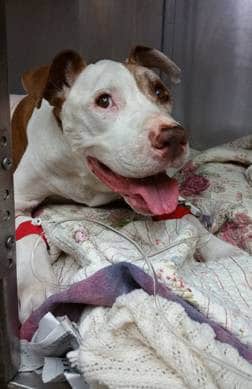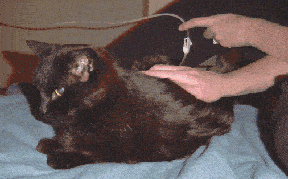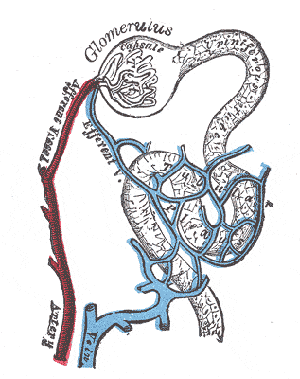Wendy Brooks, DVM, DABVP
Date Published: 07/02/2007
Date Reviewed/Revised: 06/05/2018
Additional Resources
- Kidney Failure in Dogs and Cats: Where to Begin
- Renal Failure Dietary Therapy
- Kidney Dialysis: Is it for your Pet?
- Kidney Transplants for Cats and Dogs
- Kidney Failure (Chronic) Links
- Calcium Phosphorus Balance in Dogs and Cats
- Renal Anemia, or Inadequate Red Blood Cells
- Glomerulonephritis in Dogs and Cats
- High Blood Pressure in our Pets
The Cornerstone of Treatment
Ensuring optimal hydration is the single most important aspect in the treatment of insufficient kidneys. The kidneys are made up of millions of small filtration units called nephrons. Blood is filtered by these nephrons so that waste chemicals and toxins are separated from desirable materials (such as proteins, sugars, electrolytes, etc.).
The chemicals that the body needs are returned to the circulation and the excesses and toxins are channeled into the urinary tract. The excesses and toxins must be kept dissolved in water for this process to work but the kidney, one of whose jobs is to conserve water for the body, must be able to use the smallest amount of water possible to keep the toxins dissolved. This solution of waste toxins dissolved in water is urine. It is produced continuously by the kidneys, stored in the urinary bladder, and periodically dumped into the environment.
Over a lifetime, nephrons are damaged and are no longer able to participate in the filtration process. They die from poor circulation or they become clogged by toxin sludge or they may simply wear out. Fortunately, we have many extra nephrons so losing some is not a big problem; that is, not a big problem until we have lost about two-thirds of them. At this point the remaining nephrons will have trouble keeping up with the waste removal demands of the body. Extra water is needed to remove the same amount of metabolic toxin. Since water cannot be conserved, the patient begins to drink excessively. Eventually, toxins build up and the patient feels sick.
This means that if the kidney disease is not detected until the patient is already feeling sick, less than one-third of the original number of nephrons are left. We need to maximize the efficiency of these remaining nephrons, and hopefully slow down their loss. We also need to get rid of enough toxin for the patient to feel good again. The build up of toxins is called azotemia. Actually feeling sick from the toxins is called uremia.
Diuresis
Diuresis is the medical term for increased urine production. The patient may have already been doing this somewhat by drinking excessively but there comes a point when it is not possible to drink enough and toxins build up as mentioned. When the patient first begins to feel sick, he tends to eat less and drink less. Dehydration results, which is disastrous for the patient that already had an increased need for fluids to start with. To solve these problems, we will need to correct the dehydration and maximize the circulation through the remaining nephrons. This is accomplished by giving the patient more fluid, either intravenously in the hospital or under the skin in either the hospital or the home setting.
Intravenous (IV) Fluid Therapy
Intravenous fluid therapy involves placing an intravenous catheter in the leg or neck so

Photo by MarVistaVet
that a continuous drip of fluids can be given directly into the bloodstream. The procedure is not painful nor stressful as after the catheter is placed, the patient simply relaxes in a hospital cage, periodically receiving adjunctive oral or injectable medications. After two or three days, lab tests are repeated to see what parameters have changed. Therapy is revised at that point to either continue IV fluids or discharge the patient with a new plan for home treatment.
IV fluid therapy offers many benefits to the kidney patient:
- Continuous hydration means continuous maximized nephron activity and the most efficient toxin removal.
- Rapid response to treatment (days).
- Because hospitalization is needed for this treatment, a professional staff will be monitoring the patient’s progress and can make rapid adjustments in adjunct therapy.
The disadvantages of IV fluid therapy include:
- Expense of hospitalization.
- Occasionally a patient dislikes the bandaging associated with the catheter and chews the catheter out. This incurs additional expense as the catheter is replaced and potentially the patient may need to wear an Elizabethan collar, which could be uncomfortable.
- Stress from separation of pet and owner, though we find in most cases that it is the owner’s stress and not the pet’s that dominates. Most animals are comfortable in their cages, nothing that generates fear is happening, and they quickly habituate to the cage environment and activity viewed through the bars.
Subcutaneous Fluid Therapy
The word subcutaneous means under the skin. Here, fluids are given all at once in a pocket under the skin and the patient absorbs them gradually. Initially, intravenous fluid therapy is generally considered superior to subcutaneous fluid therapy but this depends on the blood test results of the patient; some are able to skip straight to subcutaneous fluids or are forced to by the expense of intravenous therapy. Fluids are typically given every couple of days with the frequency increasing if the pet gets worse or decreasing as the pet gets better.

Photo by MarVistaVet
Advantages of subcutaneous fluids include:
- The procedure is easy for a client to learn and perform at home. Separation from the pet is not needed.
- Because hospitalization is not needed, this form of therapy is much less expensive.
- The procedure can be performed in the hospital on an outpatient basis if the patient is not cooperative at home.
- Therapy is performed usually only every couple of days (though in more advanced cases could be once or even twice a day).
Disadvantages of subcutaneous fluids include:
- The owner must be comfortable with sticking a needle into the pet’s skin. This psychological hurdle is generally overcome after the owner performs the procedure a couple of times. There are also implantable injection ports available.
- Changes in toxin level tend to occur more slowly (weeks). This makes subcutaneous fluids less appropriate for more advanced cases.
- Large dogs often require inconveniently large volumes of fluids.
- Some patients attempt to hide from the owner when they think the needle is coming, and some people feel this changes the relationship with their pet too negatively to be worthwhile. It is important to realize that this is not the usual experience with subcutaneous fluids; most people find that the comfortable life quality for the rest of the day or next several days more than compensates for the 10 minutes of unpleasant fluid administration. Most pets are cooperative for fluid administration.
See more details on how to give subcutaneous fluids.
An alternative form of fluid administration utilizes the patient’s own GI tract via an esophagostomy tube. The tube allows for relatively large amounts of water to be given without needles or hospitalization. In patients where heart disease is concurrent with kidney disease, there is a delicate balance that must be met between making the kidneys happy with extra circulating fluid yet not creating a fluid overload on the compromised heart. The GI tract creates a buffer in this situation; extra fluids will simply not be absorbed into the body. The esophagostomy method may lead to a loose stool but is much safer for a weak heart. Using the tube also precludes using an oral syringe for fluids so that there is no unpleasant struggling and far less chance of fluid aspiration into the lungs.
The esophagostomy tube is placed through a small hole in the esophagus (the tube connecting the mouth and stomach). Fluids can be administered through this tube and into the stomach thus avoiding the needle stick. The tube can stay comfortably in place for months but the hole will require regular cleaning and bandaging at home. A pet with an Esophagostomy tube should not be allowed outside unattended in case the tube or wraps become entangled in bushes, fences etc. General anesthesia is required for placement of this tube.
Related resources
- Kidney Failure (Chronic) Links for Additional Information – October 13, 2018
- Kidney Failure in Dogs and Cats: Where to Begin – August 28, 2018
- Kidney Dialysis: Is it for your Pet? – August 1, 2018
- High Blood Pressure in our Pets – July 19, 2018
- Renal Anemia, or Inadequate Red Blood Cells, in Dogs and Cats – June 13, 2018
- Glomerulonephritis in Dogs and Cats – June 1, 2017
- Renal Failure Dietary Therapy – April 16, 2017
- Calcium Phosphorus Balance in Dogs and Cats – March 3, 2017
This article was originally published on Veterinary Partner by Wendy Brooks. You can find the complete article by going here.



